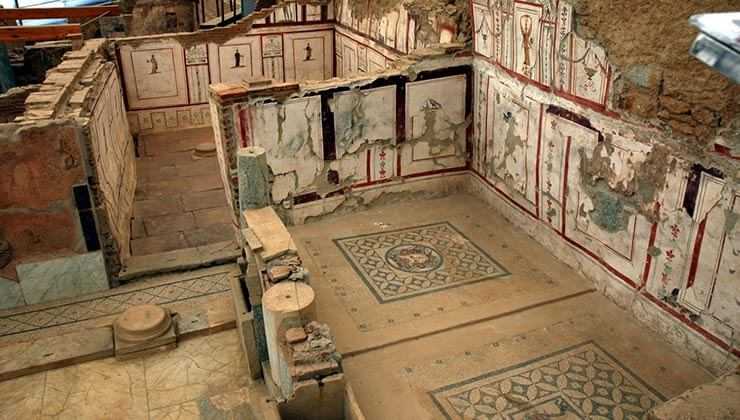At the time o the Roman Empire, Ephesus was one of the most densely populated cities in Asia Minor with probably more than two hundred thousand residents. The privileged and governing classes resided in the city centre, while artisans, farmers and the lower classes were relegated to the outskirts and surrounding area.
The wealthy residents o Ephesus lied in ‘Terrace Houses’ on the southwestern side o the Street o the Curetes, so-called because o their location on the lower sloes o Mt Bülbül. Construction o the dwellings began during the reign of Tiberius, and they were occupied continuously for 250 years 270-280 AD. The oulation in this area thinned out in the wake o the earthquake and in later years the site o ‘Terrace House Two’ was used for different purposes until the seventh century AD. The ‘Terrace Houses’ were peristyle dwellins similar in style to the houses o Rhodes, Delos and Miletus. They were built in airs on the sloes o the mountain. The interiors, which reflected the grandeur o the Roman o the Roman upper classes, were decorated with rich mosaics, frescoes and marble slabs. The houses were set, in their airs, on terraces and accessed by a flight o steep, narrow stps leading up the hill. The entrances were east and west facing. Built on either two or three floors, the houses opened on to a central, open-air peristyle courtyard. Because there were no windows inside, the courtyards took on the function of ventilation and lighting. A heating system similar to the kind used in bathhouses warmed the rooms and bathroom during the colder months; this entailed warm air being channelled through the walls to heat the rooms, kitchen, bathroom and een the lavatories were tiled with mosaics and the walls decorated with marble and frescoes. The courtyards also featured a number o statues. The human and animal motifs represented in mosaics and frescoes varied according to the particularities of the room, but frequently included Eros, lions, fish, birds and servants, as well as scenes from stage dramas and mythology The dining room (triclinium) was one of the most important rooms o the houses. Meals were taken and wine imbibed in a semi-reclining position on position on ‘klines’ (couches). Ornate relies were often to be found on the furniture, so tables of marble and bronze and the legs of wooden and wicker and married sons continued to live in the parental home. The father ruled the household singlehandedly and had the say in marriae decisions; he was almost an emblem o divine power.
It was the home too, where children received their very firs education, before going on to study at the city’s gymnasia. Education was also offerd by schools o philosophy and medicine. The presence in the home of statues and frescoes o thinkers such as Socrates and Plato indicates that thinking and philosophy played an actie role in family life. The men of the houses spent a set part of the day at the baths and at meetings in the agoras; for women, on the other hand, weaving ranked at the forefront of daytime occupations. Music, too, played an important part in Ephesus life and popular instruments included the flute (aulos), cithara .(a stringed instrument similar to a lyre) and lyra (Lyre).. The pursuit of music was regarded as a god-given talent for music was belived to have a soothing and curative effect. Children’s games included playing houses, driving pretend-chariots and riding hobbyhorses, while older children and youths preferred demanding physical stength and mental skill. Then there were games o chance played with coins, dice or bones, and these were popular with all ages. Excavations at ‘Terrace Houses Two’ have been ongoing since 1956 and, like the dwellings of their sister site, the houses unearthed in the process rise up the hillside in terraces. Restoration work carried out on some of the interiors has brought to light floor mosaics and wall frescoes depicting various animal and human motifs. The entire site of so -called ‘Terrace House Two’ covers an area of 4000 square meters and the excavation and restoration work carried out so far has identified four construction phases. Following an earthquake in the third century AD, however, the houses that were abandoned in the wake o the devastation. In Late Antiquity, though, the abandoned houses came to be used for various other purposes. And in the seventh century AD, it appears that mills, forges, potteries and similar artisan workshops set up in business on the site o the ‘Terrace Houses’. The restoration area o ‘Terrace House Two’ has been covered over to preserve the ruins against the ruins the elements. Artefacts unearthed in the course of excavations are on display at the Ephesus Museum.

